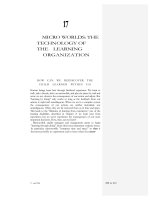Water technology
Bạn đang xem bản rút gọn của tài liệu. Xem và tải ngay bản đầy đủ của tài liệu tại đây (95.21 KB, 11 trang )
Water Technology
Introduction
•
For the existence of all living things water is essential. Without water we cannot survive. Almost all human activities
domestic, agricultural and industrial demand use of water.
•
Water from any source has to be treated before its use. The treatment to which it is subjected depends upon its use.
•
For eg. If it has to be used for drinking purposes, the treatment would include removal of objectionable colour, taste
and pathogenic micro organisms, whereas the water for industrial use require the removal of dissolved salts if it is
used for steam generation.
•
In this section we will discuss about the analysis of water and treatment of water for its industrial and domestic use.
Analysis of Water
•
Analysis of water includes the determination of different constituents in water to ascertain the
suitability of water for a specific use, and the treatment to which it should be subjected prior to its
use.
•
•
•
•
•
•
•
•
•
The following characteristics of water are usually determined during its analysis.
Hardness
Alkalinity
BOD,COD
Dissolved Carbondioxide
Free Chlorine
Silica
Chlorides
Total dissolved solids
Hard water and Soft water
•
•
Water which forms lather with soap easily is called soft water
Water which does not form lather with soap easily is called soft water.
Hardness of water
•
•
•
Hardness is the soap consuming capacity of water
Hardness of water is due to the presence of Ca and Mg salts in it. Other ions responsible for hardness
3+
3+
2+
are Al , Fe
and Mn
If Ca and Mg salts are present in water then they react with the soluble sodium soap to form insoluble
salts calcium and magnesium.
•
•
•
2C17H35COONa + CaSO4--- (C17H35COO)2Ca + Na2SO4
Sodium stearate
Insoluble salt
2C17H35COONa + MgCl2--- (C17H35COO)2Mg + 2NaCl
Types of Hardness
•
•
Temporary hardness
Permanent hardness
Temporary Hardness
•
Temporary Harness is caused by the presence of dissolved bicarbonates of calcium, magnesium
and other heavy metals and the carbonate of iron. Thus the salts responsible for temporary
hardness are Ca(HCO3)2 and Mg(HCO3)2. This hardness is also known as alkaline hardness.
•
•
•
•
•
Ca(HCO3)2---------CaCO3 + H2O + CO2
Mg(HCO3)2---------MgCO3 + H2O + CO2
Temporary hardness can also be removed by addition of calculated amount of lime [Ca(OH) 2 ]
Ca(HCO3)2+ Ca(OH)2 ------2CaCO3
+ 2H2O
Mg(HCO3)2+ Ca(OH)2------ MgCO3 + CaCO3 + 2H2O
Permanent Hardness
•
This type of hardness is due to the presence of sulphates and chlorides of calcium and
magnesium.
•
This is called permanent hardness because it cannot be removed simply by boiling.
•
This type of hardness is also known as non-carbonate hardness.
•
Special methods like lime soda process, zeolite method, ion-exchange method are used for the
removal of permanent hardness.
Hardness in terms of CaCO3 equivalent
•
Comparison of the hardness of different samples of water would be easier if the hardness caused
by different salts can be expressed in terms of single salt.
•
That is why hardness is expressed in terms of calcium carbonate equivalent. The reason for
choosing CaCO3as the standard for calculating hardness of water is :
•
•
1) its MW is exactly 100, which makes mathematical calculation easier.
2) it is the most insoluble salt and thus can be easily precipitated in water treatment process.
100 gm of CaCO3 ΞΞΞ 111gm of CaCl2
ΞΞ
136 gm of CaSO4 Ξ
95 gm of MgCl2
How to calculate harness in terms of CaCO3 equivalent
If w gm of CaCl2 is present in a water sample then the amount of CaCl 2present in terms of CaCO3
equivalent will be:
1 gm mole of CaCl2 is equivalent to 1 gm mole of CaCO3
i.e. 111gm of CaCl2
Ξ
100 gm of CaCO3
Therefore, w gm of CaCl2 is equivalent to 50/55.5 x w gm of CaCO 3
Thus equivalents of CaCO 3 =
Strength of hardness x Chemical Equivalent of CaCO 3
producing substance
Chemical Equivalent of the substance
Units of Hardness
•
6
1) parts per million (ppm): It is the parts of CaCO 3 equivalent hardness per 10 parts of water.
•
2) Milligrams per litre (mg/l):It is the no. of milligrams of CaCO 3 equivalent hardness per litre of
water.
•
3) Degree Clark (°Cl):It is the parts of CaCO 3 equivalent hardness per 70,000 parts of water.
•
5
4) Degree French(°Fr): It is the parts of CaCO 3 equivalent hardness per 10 parts of water.
•
Relation between various units of hardness
1ppm = 1mg/l = 0.1°Fr = 0.07 °Cl









